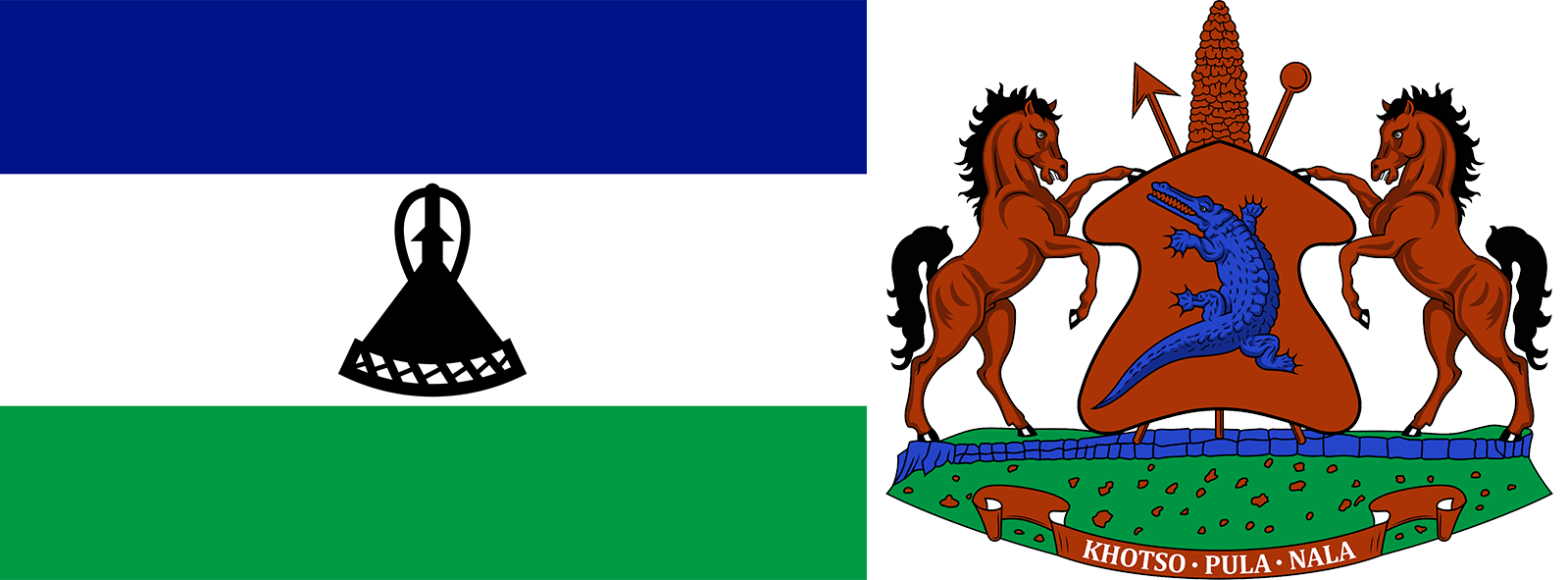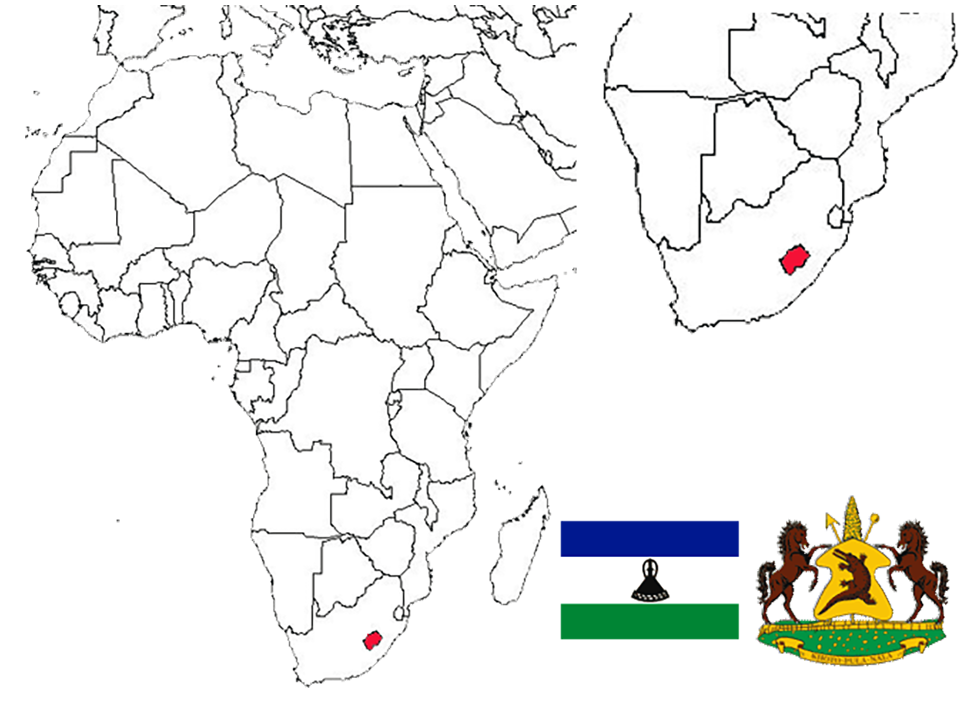FabulousFusionFood's Lesothan recipes Home Page
 The flag of Lesotho (left) and the Coat of Arms (right).
The flag of Lesotho (left) and the Coat of Arms (right).
Welcome to the summary page for FabulousFusionFood's Lesotho recipes, part of the African Continent. This page provides links to all the Lesothan recipes presented on this site, with 14 recipes in total.
Lesotho (pronounced [lɪˈsuːtu]), officially: the Kingdom of Lesotho, was formerly known as Basutoland, it is a member of the Commonwealth of Nations. The capital and largest city is Maseru and Lesotho gained independence from Britain on October 4, 1966. The name Lesotho roughly translates into 'the land of the people who speak Sesotho' and the country is completely enclosed within the borders of South Africa. Lesotho's ethno-linguistic structure consists almost entirely of the Basotho, a Bantu-speaking people. The Kwena (Bakoena) are the largest subgroup of the Sotho; other Basotho subgroups include the Natal (North) Nguni, Batloung (the Tlou), Baphuthi (the Phuti), Bafokeng, Bataung (the Tau), Bats'oeneng (the tso'ene) and the Cape (South) Nguni (Thembu). Sesotho (The Southern Sotho) and English languages are both official. Afrikaans, Zulu, Xhosa and French are also spoken. Sesotho and English are the official languages. Roman Catholics, the largest religious group, make up more than two-fifths of the population; smaller groups include the Lesotho Evangelical Church which comprises more than one-fourth of the population; Anglican, one-ninth; and other Christian and tribal religions.
Like the surrounding South Africa, Malay influences are quite strong in Lesothan cuisine and you will find spicy curries, chutneys, pickled fish and curry-marinated Pork or Lamb kebabs in this country. The basic ingredients of Lesotho cuisine include seafood, meat products and wild game, and also fresh fruits and vegetables. Meat forms the basis of many Lesothan dishes and cured and smoked hams are commonplace. However, like much of Africa the carbohydrate staples are maize, cassava, rice, plantains and millet and are often served with peanut-based stews, aubergine sauces, tomato sauces or spinach sauces.
Lesotho, formally the Kingdom of Lesotho, (Naha ea Lesotho in Sotho), formerly known as Basutoland, is a landlocked country in Southern Africa. As an enclave of South Africa, with which it shares a 1,106 km (687 mi) border,[8] it is the largest sovereign enclave in the world, and the only one outside of the Italian Peninsula. It is situated in the Maloti Mountains and contains the highest peak in Southern Africa.[9] It has an area of over 30,000 km2 (11,600 sq mi) and has a population of about two million. Its capital and largest city is Maseru. The country is also known by the nickname The Mountain Kingdom/The Kingdom in the Sky.
 The image above shows Lesotho (red) in relation to Africa (left) and Southern
The image above shows Lesotho (red) in relation to Africa (left) and Southern
Africa (right).The Sotho ethnic group (also known as Basotho), from which the country derives its name, composes 99.7% of the country's current population, making it one of the most ethnically homogeneous in the world. Their native language, Sesotho, is the official language along with English. The name Lesotho translates to 'land of the Sesotho speakers'.
Lesotho was formed in 1824 by King Moshoeshoe I. Continuous encroachments by Dutch settlers made the King enter into an agreement with the British Empire to become a protectorate in 1868 and, in 1884, a crown colony. It achieved independence in 1966, and was subsequently ruled by the Basotho National Party (BNP) for two decades. Its constitutional government was restored in 1993 after seven years of military rule. King Moshoeshoe II was exiled in 1990 but returned in 1992 and was reinstated in 1995. One year later, Moshoeshoe II died and his son Letsie III took the throne, which he still holds.
Lesotho is considered a lower middle income country with significant socioeconomic challenges. Almost half of its population is below the poverty line, and the country's HIV/AIDS prevalence rate is the second-highest in the world. However, it also targets a high rate of universal primary education and has one of the highest rates of literacy in Africa (81% as of 2021).
Etymology: The name Lesotho translates to 'land of the Sesotho speakers'.
Lesotho's food culture features likhobe (a stew with beans, berries, and sorghum), meat, and vegetables. Corn-based dishes include papa[3] and motoho (fermented sorghum porridge). Basotho cuisine includes sauces, generally less spicy than other African countries. Beetroot and carrot salads are common side dishes.
Lesotho (pronounced [lɪˈsuːtu]), officially: the Kingdom of Lesotho, was formerly known as Basutoland, it is a member of the Commonwealth of Nations. The capital and largest city is Maseru and Lesotho gained independence from Britain on October 4, 1966. The name Lesotho roughly translates into 'the land of the people who speak Sesotho' and the country is completely enclosed within the borders of South Africa. Lesotho's ethno-linguistic structure consists almost entirely of the Basotho, a Bantu-speaking people. The Kwena (Bakoena) are the largest subgroup of the Sotho; other Basotho subgroups include the Natal (North) Nguni, Batloung (the Tlou), Baphuthi (the Phuti), Bafokeng, Bataung (the Tau), Bats'oeneng (the tso'ene) and the Cape (South) Nguni (Thembu). Sesotho (The Southern Sotho) and English languages are both official. Afrikaans, Zulu, Xhosa and French are also spoken. Sesotho and English are the official languages. Roman Catholics, the largest religious group, make up more than two-fifths of the population; smaller groups include the Lesotho Evangelical Church which comprises more than one-fourth of the population; Anglican, one-ninth; and other Christian and tribal religions.
Like the surrounding South Africa, Malay influences are quite strong in Lesothan cuisine and you will find spicy curries, chutneys, pickled fish and curry-marinated Pork or Lamb kebabs in this country. The basic ingredients of Lesotho cuisine include seafood, meat products and wild game, and also fresh fruits and vegetables. Meat forms the basis of many Lesothan dishes and cured and smoked hams are commonplace. However, like much of Africa the carbohydrate staples are maize, cassava, rice, plantains and millet and are often served with peanut-based stews, aubergine sauces, tomato sauces or spinach sauces.
Lesotho, formally the Kingdom of Lesotho, (Naha ea Lesotho in Sotho), formerly known as Basutoland, is a landlocked country in Southern Africa. As an enclave of South Africa, with which it shares a 1,106 km (687 mi) border,[8] it is the largest sovereign enclave in the world, and the only one outside of the Italian Peninsula. It is situated in the Maloti Mountains and contains the highest peak in Southern Africa.[9] It has an area of over 30,000 km2 (11,600 sq mi) and has a population of about two million. Its capital and largest city is Maseru. The country is also known by the nickname The Mountain Kingdom/The Kingdom in the Sky.
 The image above shows Lesotho (red) in relation to Africa (left) and Southern
The image above shows Lesotho (red) in relation to Africa (left) and SouthernAfrica (right).
Lesotho was formed in 1824 by King Moshoeshoe I. Continuous encroachments by Dutch settlers made the King enter into an agreement with the British Empire to become a protectorate in 1868 and, in 1884, a crown colony. It achieved independence in 1966, and was subsequently ruled by the Basotho National Party (BNP) for two decades. Its constitutional government was restored in 1993 after seven years of military rule. King Moshoeshoe II was exiled in 1990 but returned in 1992 and was reinstated in 1995. One year later, Moshoeshoe II died and his son Letsie III took the throne, which he still holds.
Lesotho is considered a lower middle income country with significant socioeconomic challenges. Almost half of its population is below the poverty line, and the country's HIV/AIDS prevalence rate is the second-highest in the world. However, it also targets a high rate of universal primary education and has one of the highest rates of literacy in Africa (81% as of 2021).
Etymology: The name Lesotho translates to 'land of the Sesotho speakers'.
Lesotho Cuisine
Basotho (people of Lesotho) cuisine features African traditions and British influence.[1] Lesotho is surrounded by South Africa and it shares culinary practices with its neighbor.Lesotho's food culture features likhobe (a stew with beans, berries, and sorghum), meat, and vegetables. Corn-based dishes include papa[3] and motoho (fermented sorghum porridge). Basotho cuisine includes sauces, generally less spicy than other African countries. Beetroot and carrot salads are common side dishes.
The alphabetical list of all Lesothan recipes on this site follows, (limited to 100 recipes per page). There are 14 recipes in total:
Page 1 of 1
| Banana Soufflé Origin: Lesotho | Lesothan Chakalaka Origin: Lesotho | Moroho (Fried Greens) Origin: Lesotho |
| Beetroot, Orange and Pumpkin Sambal Origin: Lesotho | Liphaphatha (Lesothan Bakestone Bread) Origin: Lesotho | Nyekoe (Lesotho Sorghum and Beans) Origin: Lesotho |
| Bohobe ba Polata (Lesothan Fat Cakes) Origin: Lesotho | Lopo (Fried Summer Squash and Greens) Origin: Lesotho | Pap Origin: Lesotho |
| Butha-buthe (Spinach and Tangerine Soup) Origin: Lesotho | Makoenya (Lesothan Fat Cakes) Origin: Lesotho | Tomoso (Lesothan Fermentation Starter) Origin: Lesotho |
| Leqebekoane (Lesothan Steamed Bread) Origin: Lesotho | Mohoto (Fermented Sorghum Porridge) Origin: Lesotho |
Page 1 of 1